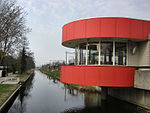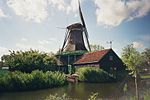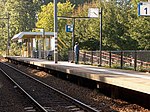De Held Jozua, Zaandam
1719 establishments in the Dutch Republic18th-century architecture in the NetherlandsRijksmonuments in North HollandWindmills completed in 1719Windmills in North Holland ... and 1 more
Zaandam

De Held Jozua (English: The Hero Joshua) is a paltrok mill in Zaandam, Netherlands which has been restored to working order. As all Dutch paltrok mills it is a windpowered sawmill. The mill is listed as a Rijksmonument, number 40094.
Excerpt from the Wikipedia article De Held Jozua, Zaandam (License: CC BY-SA 3.0, Authors, Images).De Held Jozua, Zaandam
Held Jozuapad, Zaanstad
Geographical coordinates (GPS) Address External links Nearby Places Show on map
Geographical coordinates (GPS)
| Latitude | Longitude |
|---|---|
| N 52.443794 ° | E 4.807006 ° |
Address
De Held Jozua
Held Jozuapad
1507 ER Zaanstad
North Holland, Netherlands
Open on Google Maps









